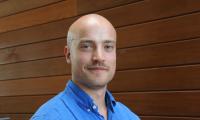Jakob Sørensen
DARE: Cracking the code to spinal cord connections
Jakob Sørensen is hunting down the connections in the central nervous system that are messed up by a spinal cord injury. His DARE fellowship will take him to San Francisco to conduct research at one of the world’s leading universities and spend the next year trying to crack the code to the spinal cord network.
Spasticity is often one of the results of a spinal cord injury and consists of abnormally increased muscle tone or tightness and involuntary muscle contractions.
It arises as a result of dysfunction in the motor neurons that control movement and muscles. Normally, muscle tone is maintained through a balanced interaction between the networks in the brain and spinal cord, allowing for fluid and coordinated muscle movement. Spasticity happens when this balance is disrupted due to pathological conditions in the central nervous system, especially in the connections between the brain and spinal cord.
The neural networks that control movement include the forebrain, cerebellum and brainstem. Nevertheless, the final executive circuits for movement are found in the spinal cord. The spinal cord circuitry is capable of autonomously generating rhythmic and coordinated activity, which can be mathematically modulated by firing-phase rotation as well as a specific sequential activity. Spinal cord injuries lead to the brain losing control over these circuits, causing pathological changes in connection strengths and triggering spasticity.
Associate Professor Rune Berg, Jakob’s Danish mentor, has conducted extensive research into spinal cord activity and is developing new advanced mathematical models for spinal cord networks. His interdisciplinary research combines quantitative methods from maths and physics with experiments based on electrophysiology, genetics and other biological tools in an integrated approach that provides an in-depth understanding of the central nervous system network, especially the area of motor functions. Berg’s laboratory specialises in computational neuroscience, large-array electrophysiology and the development of specialised equipment, which enables detailed characterisation of brain cell populations and their self-organisation.
Professor Peter Tass specialises in the study and definition of new neuromodulatory treatments, i.e. ones that induce lasting therapeutic change by altering the activity and strength of brain cell connections. Deploying the principles of dynamic self-organisation, synaptic plasticity and oscillatory phenomena in the central nervous system makes it possible to draw up treatment strategies that make permanent changes to brain networks and activity. Tass’s laboratory has expertise in neurosurgery, computational neuroscience and mathematics.
Sørensen will be at the centre of a new collaboration designed to combine multiple areas of expertise to define a neuromodulatory paradigm for the new, non-invasive treatment for spasticity. The aim is to generate enduring change in the spastic circuits and restore healthier patterns of network connectivity.
Jakob Sørensen (26) studies medicine at the University of Copenhagen. He will graduate following the year of research. He is one of five Danish medical students participating in the Lundbeck Foundation’s Danish American Research Exchange (DARE) programme, which offers the opportunity to study and research at some of the world’s top universities.
